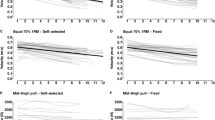Abstract
The purpose of this study was to evaluate the effects of how goals are established in operant, graded activity training. Consequently, five men and one woman with long-term back pain served as their own controls and each subject participated in two exercises: sit-ups and trunk extensions. In the Predetermined Condition, the goals were established, as in many programs, by the physical therapist for the entire treatment period after an examination, interview with the patient, and a baseline period of training. By contrast, in the Negotiated Condition, training goals were based on the individual subject's and the physical therapist's views as well as prior results. All subjects received both types of training programs, but the assignment of exercise type to the condition was randomized to control for possible differences inherent in the exercise itself. Results showed that every subject obtained larger improvements in the Negotiated Condition regardless of type of exercise than in the Predetermined Condition. The difference was particularly clear for four of the six subjects and the overall average improvement was more than twice as great for the Negotiated Condition (median increase = 149%) relative to the Predetermined Condition (median increase = 67%). Part of the difference appeared to be that the Negotiated Condition increased variability in results so that some subjects produced much higher increases. These data suggest that the method employed to determine the training goals in operant activities training is an important variable. This information might be utilized to enhance the effects of the program.
Similar content being viewed by others
REFERENCES
Fordyce WE. Behavioral methods for chronic pain and illness. St. Louis, MO: Mosby, 1976.
Doleys DM, Crocker M, Patton D. Response of patients with chronic pain to exercise quotas. Phys Ther 1982; 62: 1111–1114.
Cairns D, Pasino J. Comparison of verbal reinforcement and feedback in the operant treatment of disability due to chronic low back pain. Behav Ther 1977; 8: 621–630.
Geiger G, Todd DD, Clark HB, Miller RP, Kori SH. The effects of feedback and contingent reinforcement on the exercise behavior of chronic pain patients. Pain 1992; 49: 179–185.
Linton SJ, Melin L, Stjernlöf K. The effects of applied relaxation and operant activity training on chronic pain. Behav Psychother 1985; 13: 87–100.
Linton SJ, Götestam KG. A controlled study of the effects of applied relaxation and applied relaxation plus operant procedures on the regulation of chronic pain. Br J Clin Psychol 1984; 23: 291–299.
Linton SJ. Behavioral remediation of chronic pain: A status report. Pain 1986; 24: 125–141.
Flor H, Fydrich T, Turk DC. Efficacy of multidisciplinary pain treatment centers: A meta-analytic review. Pain 1992; 49: 221–230.
Mayer TG, Gatchel RJ, Mayer H, Kishino NC, Keeley J, Mooney V. A prospective two-year study of functional restoration in industrial low back injury. JAMA 1987; 258: 1763–1767.
Hazard RG, Matheson LN, Lehmann TR, Frymoyer JW. Rehabilitation of the patient with chronic low back pain. In: Pope MH, Andersson GB, Frymoyer JW, Chaffin, DB. eds. Occupational low back pain: Assessment, treatment, and prevention. St. Louis: Mosby-Year Book, 1991, pp. 194–208.
Pope MH, Andersson GB, Frymoyer J, Chaffin DG. Occupational low back pain: Assessment, treatment, and prevention. St. Louis: Mosby-Year Book, 1991.
Feuerstein M, Zastowny TR. Occupational rehabilitation: Multidisciplinary management of work-related musculoskeletal pain and disability. In: Gatchel R, Turk DC, eds. Psychological approaches to pain management: A practitioner's handbook. New York: Guiford Publications, 1996, pp. 458–485.
Cutler RB, Fishbain DA, Rosomoff HL, Abdel-Moty E, Khalil TM, Rosomoff RS. Does nonsurgical pain center treatment of chronic pain return patients to work? a review and meta-analysis of the literature. Spine 1994; 19: 643–652.
Linton SJ. Psychological interventions for patients with chronic back pain. Geneva: World Health Organization, Behavioral science learning modules, 1993.
Hersen M, Barlow DH. Single case experimental designs. New York: Pergamon Press, 1978.
Kazdin AE. Research design in clinical psychology. New York: Harper & Row, 1980.
Biering-Sörensen F. Physical measurements as risk indicators for low back trouble over a one year period. Spine 1984; 9: 106–119.
McQuade KJ, Turner JA, Buchner DM. Physical fitness and chronic low back pain: An analysis of the relationships among fitness, functional limitations, and depression. Clin Orthop 1988; 233: 198–204.
Linton SJ. Chronic back pain: Activities training and physical therapy. Behav Med 1994; 20: 105–111.
Robert JJ, Blide RW, McWhorter K, Coursey C. The effects of a work hardening program on cardiovascular fitness and muscular strength. Spine 1995; 20: 1187–1193.
Ricke SA, Chara PJ, Jr., Johnson MM. Work hardening: Evidence for success of a program. Psychol Rep 1995; 77(3, Pt 2): 1077–1078.
Lethem J, Slade PD, Troup JDG, Bentley G. Outline of a fear-avoidance model of exaggerated pain perceptions. Behav Res and Ther 1983; 21: 401–408.
Vlaeyen JWS, Kole-Snijders AMJ, Boeren RGB, van Eek H. Fear of movement/(re)injury in chronic low back pain and its relation to behavioral performance. Pain 1995; 62: 363–372.
Lackner JM, Carosella AM, Feuerstein M. Pain expectancies, pain and functional self-efficacy expectancies as determinants of disability in patients with chronic low back disorders. J Consult Clin Psychol 1996; 64: 212–220.
Author information
Authors and Affiliations
Rights and permissions
About this article
Cite this article
Linton, S.J., Jannert, M. & Overmeer, T. Whose Goals Should Guide? A Comparison of Two Forms of Goal Formulation on Operant Activity Training. J Occup Rehabil 9, 97–105 (1999). https://doi.org/10.1023/A:1021314104018
Issue Date:
DOI: https://doi.org/10.1023/A:1021314104018




